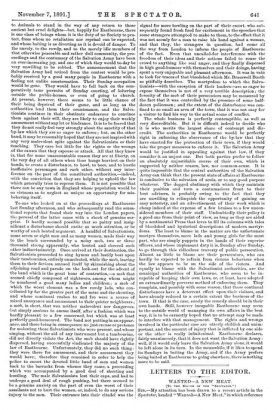LETTERS TO THE EDITOR.
WANTED—A NEW MEAT.
[To THIE EDITOR Or rag "SpzcrAToR."1 Sxn,—My attention has been drawn to a recent article in the Spectator, headed " Wanted—A New Me it," in which reference
was made to an attempt to graze venison for the London market by a Suffolk squire in the last century. As I am in possession of the records referred to, I think a few extracts may interest your readers.
In April, 1747, a seven-acre paddock was stocked with 22 deer-13 bucks, 9 does—which were bought in at 12s. each. The first buck was killed in honour of the christening of a niece, " as fine a fat buck as could be found in Suffolk," and the squire sent a portion to a brother in London, who was asked to find out the value of the meat.
The praises bestowed on the haunch sent, which weighed 30 lb., encouraged the squire to hope for a good price in dis- posing of his other bucks. In August, 1748, he had to be content with an offer from a pastrycook in Leadenhall Street of £9 for a couple of bucks, and a promise of " more if it could be afforded." Great was the squire's dissatisfaction when he received but £8 2s.,-18s. being deducted for carriage by coach. He first thought that the charge was an imposition, for he states that a person weighing not so much as his two bucks could be carried from Ipswich to London for 68. 6d. Eventually the regular price paid him was £5 per carcass, from which 9s. for carriage was to be deducted.
The first two carcasses weighed 124 lb. and 122 lb. :— Two haunches ... 56 lb. 46 lb.
Two plates with shoulder ... 58 lb. 641b.
Chine lO lb. 121b.
1241b. 1221b.
The skin belonged to the squire, but was in each case sent with the carcass, with directions for it to be "dressed in oyl ;" when three or four were ready, they were sent back to Ipswich by " boy," carriage by coach being too expensive, and were used for breeches and gloves.
An average of five bucks a year were sold off the seven-acre paddock between 1748 and 1753. Then I find mentioned in a letter that " half the stock were lost from hurts in the back," and from this date there is no further mention of venison. The net profit of £4 lls. per carcass of about 120 lb. is named by the squire himself as "tolerably successful," and is equivalent to 6s. per stone of 8 lb.
The purchasers are called "pastrycooks :" on receipt of a letter from them, a buck was shot, cut up, packed in a hamper, and sent same day by coach. Particular care was to be observed in cutting up ; and on one occasion, when complaint was made, explanation was given that owing to the buck being twice missed before it was shot, there had been barely time to prepare the venison in time for the coach.—I am, Sir, &c.,



















































 Previous page
Previous page